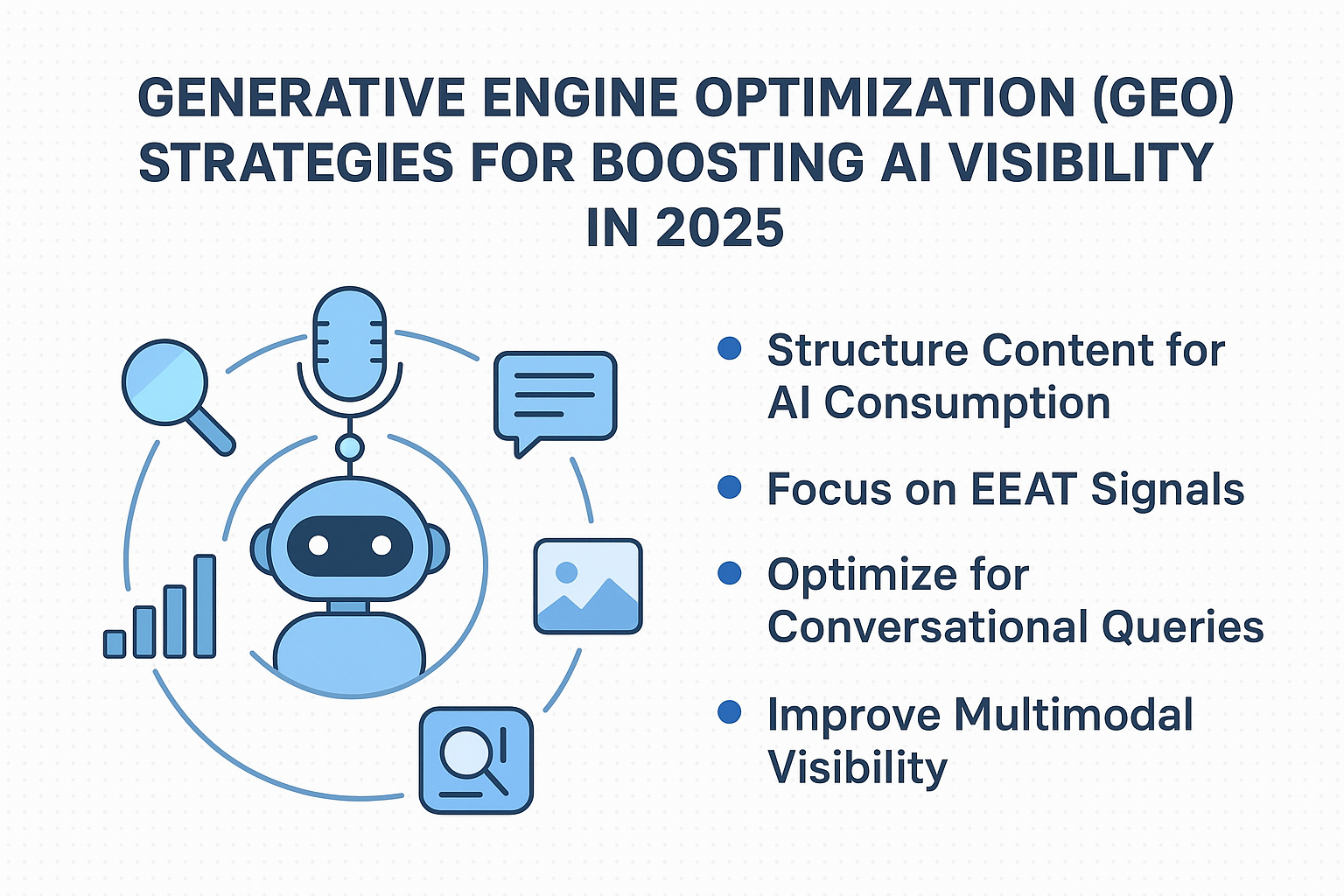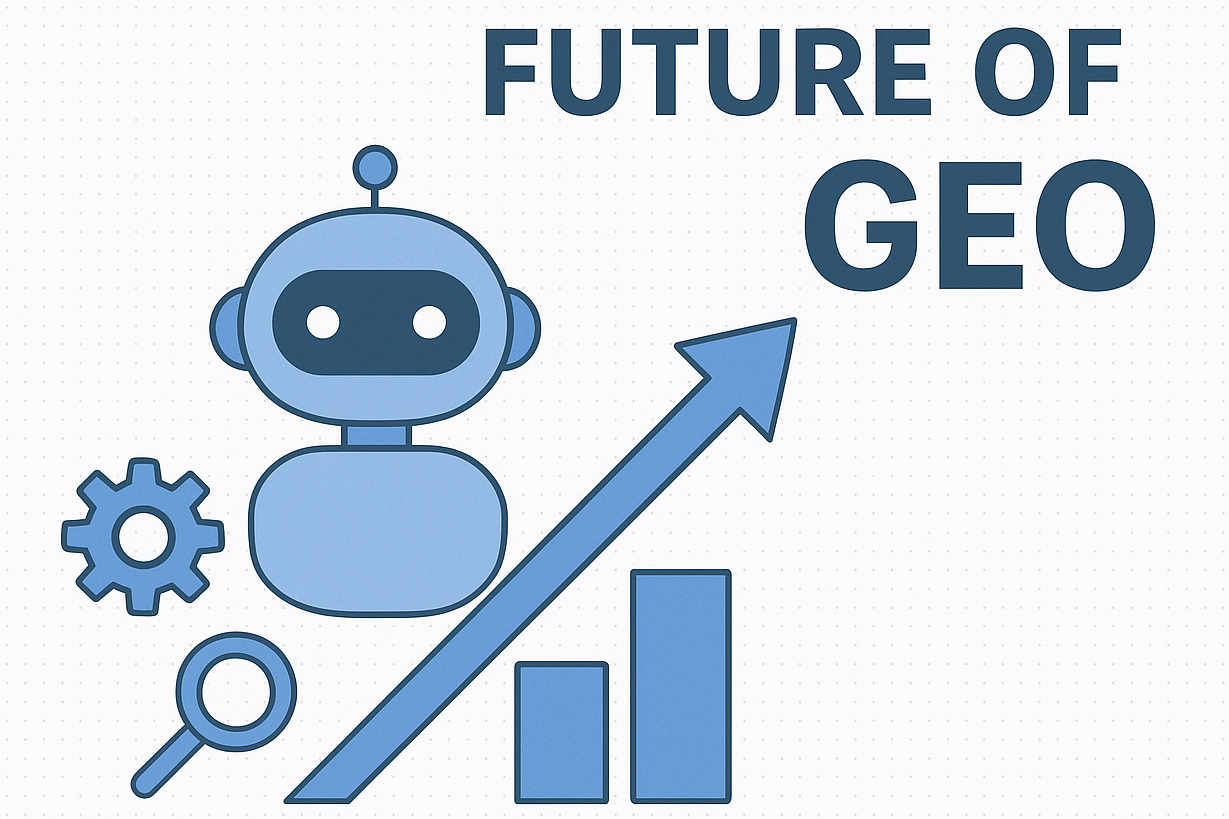
In 2025, search is no longer limited to traditional search engines like Google or Bing. With the rise of generative AI platforms such as ChatGPT, Gemini, Perplexity, and other AI-driven assistants, businesses face a new challenge: making their content discoverable in conversations generated by artificial intelligence. This is where Generative Engine Optimisation (GEO) becomes essential. GEO focuses on optimising content not only for search engines but also for AI-driven tools that summarise, recommend, and generate responses based on massive datasets.
We will explore the importance of GEO in 2025, outline practical GEO strategies for boosting AI visibility, and compare them with SEO strategies in 2025 and AEO strategies in 2025.

Why GEO Matters in 2025?
Generative AI is reshaping how users search for information. Instead of typing a query into Google, people increasingly ask AI chatbots and voice assistants for direct answers. This means:
- Content must be AI-readable and AI-trainable.
- AI models prefer structured, authoritative, and context-rich sources.
- If your brand does not appear in generative answers, you lose digital visibility—although your SEO rankings remain high.That is why forward-thinking businesses are adopting GEO strategies in 2025 as part of their core digital marketing efforts.
Understanding the Relationship Between SEO, AEO, and GEO:
Before diving into the tactics, let us clarify how GEO fits in with existing optimization approaches:
SEO Strategies in 2025: Traditional search optimization is still alive but has evolved. Core Web Vitals, MEAT (Experience, Expertise, Authority, Trust), and semantic content remain key.
Answer Engine Optimization focuses on optimizing for featured snippets, voice search, and direct-answer boxes. It ensures that your content provides clear, concise answers.
Goes a step further by optimizing content so that generative AI systems select, summarize, and recommend your information in conversational responses.
Together, these three pillars define the future of visibility across both search engines and AI-driven platforms.
GEO Strategies in 2025: How to Boost AI Visibility:
Here are practical GEO strategies for boosting AI visibility that brands should implement in 2025:
1. Structure Content for AI Consumption.
AI models prefer structured data because it allows them to interpret and summarise content effectively. To optimize for generative engines:
- Use schema markup for products, FAQs, and articles.
- Create clear heading hierarchies (H1–H3).
- Write context-rich paragraphs that answer queries directly.
This makes it easier for AI systems to extract and repurpose your content in their responses.
2. Focus on MEAT Signals.
Just like SEO, authority and trust are critical for GEO. AI systems prioritize sources with credibility, so you should:
- Build author bios that highlight real-world expertise.
- Publish research-backed, cited content.
- Gain mentions and links from authoritative sites.
By strengthening MEAT, you increase your chances of being chosen by AI as a reliable reference.
3. Optimize for Conversational Queries:
AI engines often generate answers to natural, conversational questions. Instead of focusing solely on keywords like “best marketing tools,” GEO strategies involve:
- Writing Q&A-style content that matches how users talk to AI.
- Using long-tail queries phrased as questions.
- Structuring content around problem-solution storytelling.
This makes your content more likely to appear in chatbot-generated answers.
4. Improve Multimodal Visibility
In 2025, generative AI is multimodal—combining text, images, and even video in responses. To optimize:
- Create infographics, charts, and visuals that AI can cite.
- Upload transcripts and captions for video content.
- Ensure alt text and metadata are optimized for image recognition.
This holistic approach ensures your brand gets visibility across different AI-generated formats.
5. Leverage First-Party Data and Unique Insights
Generative AI tools rely on existing public data. To stand out:
- Publish original research, surveys, and case studies.
- Provide industry benchmarks not available elsewhere.
- Create thought leadership content with unique perspectives.
AI prefers fresh, unique, and valuable data sources. If your content is widely cited, AI models are more likely to reference it.
6. Build AI-Friendly Content Hubs.
Instead of scattered blog posts, GEO favors thematic clusters of information:
- Build content hubs around key topics.
- Interlink pages with semantic relevance.
- Provide comprehensive guides instead of fragmented pieces.
This increases your brand’s chances of being recognized as an authoritative knowledge source in AI answers.
7. Monitor AI Mentions and Visibility
Just as SEO professionals track rankings, GEO requires monitoring AI visibility:
- Use emerging tools that track brand mentions in AI platforms.
- Test queries in ChatGPT, Gemini, and Perplexity to see if your brand appears.
- Adjust strategies based on AI-generated results.
This is still a developing area, but in 2025, tracking AI visibility is as critical as monitoring Google SERPs.
AEO Strategies in 2025 and Their Role in GEO:
AEO strategies in 2025—Answer Engine Optimization—remain important because generative AI often builds responses from the same type of structured answers that fuel featured snippets. To integrate AEO with GEO:
- Ensure FAQ sections are updated.
- Optimize for voice search queries.
- Provide short, precise answers followed by in-depth context.
This creates a balance where your content works for both search engines and generative platforms.
Challenges of GEO in 2025:
While GEO offers exciting opportunities, it comes with challenges:
- Lack of standard measurement tools – Tracking AI visibility is still in its infancy.
- Dependence on AI training data – You cannot control which sources an AI model has already absorbed.
- Risk of content misuse – AI may summarize your work without proper attribution.
Despite these hurdles, early adopters of GEO will enjoy a competitive advantage in digital visibility.

Future of GEO: Where it is Headed
Looking beyond 2025, we can expect:
- AI visibility audits becoming standard for brands.
- More transparency in how AI models choose sources.
- Integration of SEO, AEO, and GEO into a unified optimization strategy.
Businesses that adapt now will secure long-term authority in the AI-driven search landscape.
Conclusion:
The future of digital marketing lies not just in ranking high on Google but in being part of the answers people receive from AI. GEO strategies for boosting AI visibility in 2025 represent the next evolution of search optimization. By combining SEO strategies in 2025, AEO strategies in 2025, and structured GEO practices, brands can ensure they remain discoverable, authoritative, and trusted in the age of generative engines.
Now is the time to start experimenting, auditing, and building AI-friendly content ecosystems. The earlier you adapt, the more visible your brand will be in the conversations shaping the future of digital discovery.
